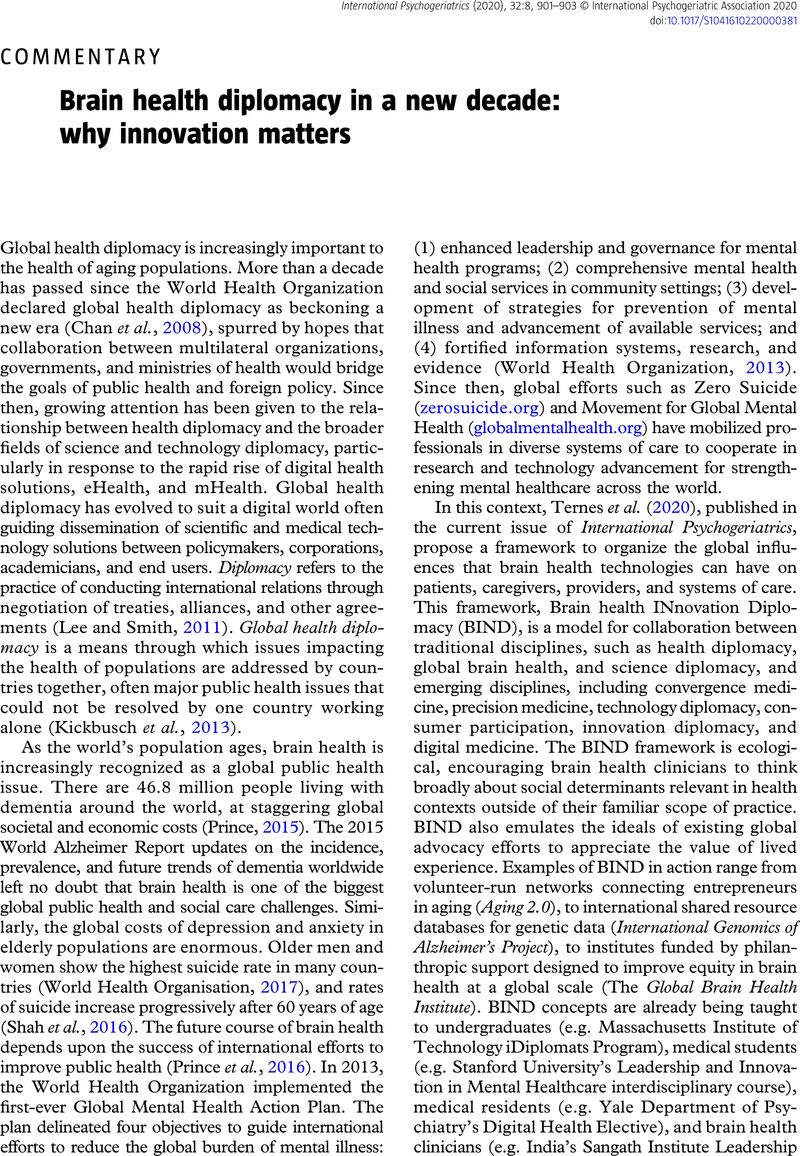No CrossRef data available.
Article contents
Brain health diplomacy in a new decade: why innovation matters
Published online by Cambridge University Press: 16 September 2020
Abstract
An abstract is not available for this content so a preview has been provided. Please use the Get access link above for information on how to access this content.

- Type
- Commentary
- Information
- International Psychogeriatrics , Volume 32 , Issue 8: Issue Theme: Technology for Brain Health and Artificial Wisdom , August 2020 , pp. 901 - 903
- Copyright
- © International Psychogeriatric Association 2020
References
Chan, M., Gahr Store, J. and Kouchner, B. (2008). Foreign policy and global public health: working together towards common golas. Bulletin of the World Health Organization, 86, 498–498. doi: 10.2471/BLT.08.056002.Google Scholar
Kickbusch, I.et al. (2013). Global Health Diplomacy: Concepts, Issues, Actors, Instruments, Fora and Cases.
New York: Springer.CrossRefGoogle Scholar
Lee, K. and Smith, R. (2011). What is ‘Global Health Diplomacy’? A conceptual review. Global Health Governance, 5, 1–12.Google Scholar
Liu, J.X.et al. (2017). Global health workforce labor market projections for 2030. Human Resources for Health, 15, 1–12. doi: 10.1186/s12960-017-0187-2.Google ScholarPubMed
Prince, M.et al. (2016). Recent global trends in the prevalence and incidence of dementia, and survival with dementia. Alzheimer’s Research & Therapy, 8, 1–13. doi: 10.1186/s13195-016-0188-8.Google ScholarPubMed
Prince, M.J. (2015). World Alzheimer Report 2015: The Global Impact of Dementia: An Analysis of Prevalence, Incidence, Cost and Trends. London: Alzheimer’s Disease International.Google Scholar
Shah, A.et al. (2016). Suicide rates in five-year age-bands after the age of 60 years: The international landscape. Aging and Mental Health, 20, 131–138. doi: 10.1080/13607863.2015.1055552.CrossRefGoogle ScholarPubMed
Shiovitz-Ezra, S. and Ayalon, L. (2010). Situational versus chronic loneliness as risk factors for all-cause mortality. International Psychogeriatrics, 22, 455–462. doi: 10.1017/S1041610209991426.CrossRefGoogle ScholarPubMed
Ternes, K., Iyengar, V., Lavretsky, H.et al. (2020). Brain health INnovation Diplomacy (BIND): a model binding diverse disciplines to manage the promise and perils of technological innovation. International Pyschogeriatrics, 32, 955–979. doi: 10.1017/S1041610219002266.CrossRefGoogle Scholar
World Health Organisation (2017). Suicide Data. Available at: http://www.who.int/mental_health/prevention/suicide/suicideprevent/en; accessed 17 February 2020.Google Scholar
World Health Organization (2013). Mental Health Action Plan 2013-2020. Geneva: WHO Document Production Services.Google Scholar


